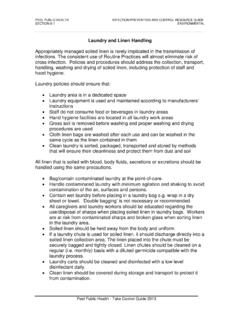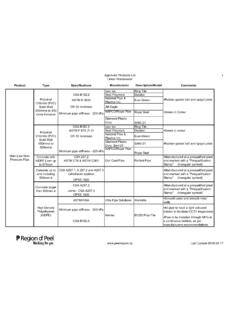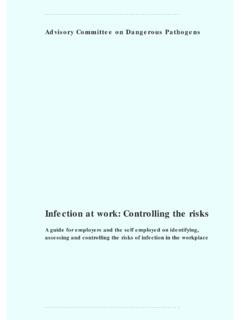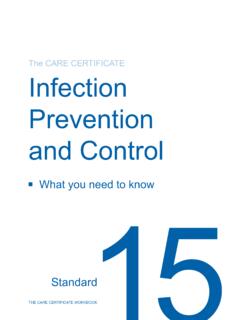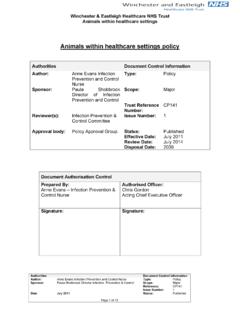Transcription of The Chain of Infection - Region of Peel
1 PEEL PUBLIC HEALTH Infection PREVENTION AND CONTROL RESOURCE GUIDE. SECTION 2-1 ROUTINE PRACTICES AND ADDITIONAL PRECAUTIONS. THE Chain OF Infection . What is an Infection ? Understanding what causes Infection and disease is the first step in being able to prevent and control it. An Infection occurs when a disease-causing organism enters the body and starts to multiply, often causing signs and symptoms of Infection . Such signs and symptoms can include redness, swelling, heat, pain, coughing, nasal discharge, eye discharge, diarrhea, etc. Or there may be absence of symptoms. In the case of the elderly whose immune system is compromised illness may result and symptoms may be less defined. fever may be absent and symptoms such as unsteady gait or changes in cognitive function may manifest. A healthcare acquired Infection (previously known as nosocomial Infection ) is an Infection that is acquired during the resident's stay in the facility, and which was not present or incubating at the time of admission.
2 In order for infections to occur, a series of events must happen. This is called the Chain of Infection . There are six links in the Chain of transmission and each link must connect for an Infection to occur. Our goal is to break the Chain and stop the Infection from occurring. To do this, it is essential to understand each link and how they connect. Peel Public Health - Take Control Guide 2011. PEEL PUBLIC HEALTH Infection PREVENTION AND CONTROL RESOURCE GUIDE. SECTION 2-1 ROUTINE PRACTICES AND ADDITIONAL PRECAUTIONS. Infectious Agent This can be a bacteria, virus, parasites or prions. Any organism is capable of causing Infection if all the links/components are present. Increasingly, in healthcare, transmission of antibiotic resistant organisms presents challenges to the healthcare sector and causes significant morbidity to the clients we serve.
3 Bacteria are in us, on us and around us in our environment. Bacteria play an important role in keeping us healthy by such activities as aiding with digestion. Each of us has our own unique group of bacteria that are part of us. We call this our resident' flora. Throughout the day, as we interact with others and the environment, we pick up' other bacteria. These are referred to as transient' flora. It is these bacteria that may be harmful to us or others with whom we are in contact. Hand hygiene is a simple, effective way of removing transient bacteria from our hands. Viruses are responsible for many illnesses respiratory illnesses (influenza, colds), gastrointestinal illnesses (norovirus) and illnesses that affect our immune systems (HIV, hepatitis B, hepatitis C). Viruses are not part of our resident flora although some viruses (varicella), herpes) may remain dormant in our bodies after we have been infected by them.
4 Parasites are present throughout our environment. Individuals with poorly functioning immune systems are most at risk for acquiring infections after being exposed. Reservoir A reservoir is the place where an infectious agent lives and reproduces in such a manner that it can be transmitted. Infectious agents can live in or on people, animals, insects, soil or water. Portal of Exit When the infectious agent leaves the reservoir, spread of Infection is likely to occur. This includes: excretions and secretions non intact skin ( , draining wounds). respiratory tract ( , sneezing, coughing, talking). gastrointestinal tract ( , vomiting, diarrhea, stool). mucous membranes (eyes, nose, mouth, vagina). Peel Public Health - Take Control Guide 2011. PEEL PUBLIC HEALTH Infection PREVENTION AND CONTROL RESOURCE GUIDE.
5 SECTION 2-1 ROUTINE PRACTICES AND ADDITIONAL PRECAUTIONS. Modes of Transmission The way that organisms travel from the reservoir to a host is known as the mode of transmission. Every form of direct and indirect human contact provides an opportunity for disease-producing organisms to be transmitted. Contact Transmission: Contact transmission is the most common route of transmission of organisms in health care settings. It may be direct ( contaminated hands) or indirect ( contaminated equipment). Examples of diseases caused by direct contact transmission include scabies and pediculosis. Droplet Transmission Droplet transmission refers to large droplets that are generated from the respiratory tract of infected individual during coughing, sneezing or laughing or during such procedures as suctioning.
6 These droplets are heavier than air and can only travel about two metres (6 feet) before they fall to the ground. In order for infections to occur they must come into contact with the mucous membranes of the eyes, nose or mouth of a susceptible host. Some droplets may also be transmitted through indirect contact. This occurs when the susceptible host touches surfaces which have been contaminated with these droplets and then directly inoculates their mucous membranes by touching their eyes, nose or mouth.. Some examples of droplet transmission include influenza and meningitis. Airborne Transmission: Airborne transmission occurs when an individual with an organism/disease that is transmitted by the airborne route expels the organism from their respiratory tract by coughing, laughing, singing and sneezing.
7 Once in the air, the organism evaporates until only the core, or nucleus, is left. It is now very small and very light and can remain suspended on air currents remaining in a room until the air has been exchanged with fresh air. While the organisms remain in the air, they may enter the respiratory system of an individual who is in that area. The individual breathes the organism in and it must then bypass the defenses of the respiratory system and enter the lungs of the individual where it is disseminated throughout the body. There are three common diseases that are transmitted through the airborne route; chicken pox (varicella), tuberculosis, and measles Vector Vector transmission occurs when an insect or animal transmits disease to humans. Lyme disease, Malaria, West Nile Virus and Dengue fever Portal of Entry The point where the infectious agent enters a new host is known as the portal of entry, such as: Peel Public Health - Take Control Guide 2011.
8 PEEL PUBLIC HEALTH Infection PREVENTION AND CONTROL RESOURCE GUIDE. SECTION 2-1 ROUTINE PRACTICES AND ADDITIONAL PRECAUTIONS. non intact skin ( , broken skin such as bed sores or wounds coming in contact with contaminated material). respiratory tract gastrointestinal tract ( , eating contaminated food). mucous membranes ( , eyes, nose or mouth exposures with infectious agents). parenteral ( , exposure to a contaminated sharp instrument Susceptible Host All individuals may be susceptible depending on the exposure and their own general health status. Individuals who have never been exposed to the organism may become ill because they do not have antibodies to protect them ( communicable diseases) either through immunization or previous Infection . Factors that increase the risk of susceptibility are: age (either very young or very old).)
9 Underlying medical conditions treatments or invasive devices poor nutrition/general health . Additional Resources An interactive resource on the Chain of Transmission has been developed by the Regional Infection Control Networks (RICN and can be found at: Peel Public Health - Take Control Guide 2011.)

